Weather Files for the Calibration of Building Energy Models
Abstract
:1. Introduction
2. Methodology
2.1. Calibration Process with On-Site and Third-Party Weather Data
- The correlation coefficient of Spearman’s range (, Equation (6)) estimates the level of correspondence of the form. This uncertainty index measures the degree of correspondence that exists between the ranges that are assigned to the values of the analyzed variables.
2.2. Weather File Creation for the Cost/Effectiveness Analysis
2.3. Case Study
3. Results and Discussion
3.1. Comparison of In Situ and Third-Party Weather Files
3.2. Simulation and Calibration Results: On-Site vs. Third-Party Weather Data
3.3. Simulation and Calibration Results: Combination of On-Site and Third-Party Weather Data
4. Conclusions
Author Contributions
Funding
Institutional Review Board Statement
Informed Consent Statement
Data Availability Statement
Acknowledgments
Conflicts of Interest
Abbreviations
| AMY | actual meteorological year |
| BEM | building energy models |
| CV(RMSE) | coefficient of variation of root mean square error |
| DHI | diffuse horizontal irradiation |
| ECM | energy conservation measures |
| FEMP | federal energy management program |
| FDD | fault detection diagnosis |
| GHI | global horizontal irradiation |
| IPMVP | international performance measurement and verification protocol |
| MAE | mean absolute error |
| MPC | model predictive control |
| NMBE | normalized mean bias error |
| NSGA-ii | non-dominated sorting genetic algorithm |
| P2H | power to heat |
| RH | relative humidity |
| ROLBS | randomly ordered logarithmic binary sequence |
| TMY | typical meteorological year |
| WD | wind direction |
| WS | wind speed |
Appendix A. Complementary Data from the Base and Calibration Processes by the Thermal Zone, with the Different Weather Files
| Base Model | Weather File Name | Simulation Period | Living Room | Children Room | Bedroom | Kitchen | Global Index | |||||
|---|---|---|---|---|---|---|---|---|---|---|---|---|
| MAE (C) | (%) | MAE (C) | (%) | MAE (C) | (%) | MAE (C) | (%) | MAE (C) | (%) | |||
| N2 | On-site | Training | 1.54 | 96.6 | 0.25 | 98.6 | 0.50 | 97.2 | 0.97 | 96.5 | 0.81 | 93.0 |
| N2 | Third-party | Training | 1.21 | 94.9 | 0.66 | 99.1 | 1.16 | 94.7 | 2.57 | 90.5 | 1.40 | 87.9 |
| N2 | Weather_T | Training | 1.32 | 95.7 | 0.39 | 98.6 | 0.81 | 96.0 | 2.09 | 92.4 | 1.15 | 88.2 |
| N2 | Weather_GHI | Training | 1.27 | 95.5 | 0.61 | 99.3 | 1.14 | 93.7 | 1.38 | 94.4 | 1.10 | 91.8 |
| N2 | Weather_DHI | Training | 1.11 | 95.5 | 0.59 | 99.0 | 0.90 | 97.1 | 2.27 | 92.9 | 1.22 | 90.0 |
| N2 | Weather_WS | Training | 1.21 | 94.9 | 0.64 | 99.1 | 1.13 | 94.7 | 2.53 | 90.6 | 1.38 | 88.0 |
| N2 | Weather_WD | Training | 1.21 | 94.9 | 0.66 | 99.1 | 1.16 | 94.7 | 2.57 | 90.5 | 1.40 | 87.9 |
| N2 | Weather_RH | Training | 1.21 | 94.9 | 0.67 | 99.1 | 1.17 | 94.7 | 2.59 | 90.5 | 1.41 | 87.8 |
| Base Model | Weather File Name | Simulation Period | Living Room | Children Room | Bedroom | Kitchen | Global Index | |||||
|---|---|---|---|---|---|---|---|---|---|---|---|---|
| MAE (C) | (%) | MAE (C) | (%) | MAE (C) | (%) | MAE (C) | (%) | MAE (C) | (%) | |||
| N2 | On-site | Checking | 1.82 | 91.9 | 0.22 | 99.6 | 0.32 | 98.3 | 0.65 | 95.5 | 0.75 | 90.1 |
| N2 | Third-party | Checking | 0.846 | 87.5 | 0.73 | 99.4 | 0.93 | 97.2 | 2.09 | 86.2 | 1.15 | 84.5 |
| N2 | Weather_T | Checking | 1.23 | 90.3 | 0.41 | 99.5 | 0.57 | 97.0 | 1.57 | 89.1 | 0.95 | 84.5 |
| N2 | Weather_GHI | Checking | 1.09 | 88.3 | 0.59 | 99.4 | 0.81 | 97.2 | 0.92 | 90.9 | 0.85 | 88.9 |
| N2 | Weather_DHI | Checking | 0.79 | 88.9 | 0.69 | 99.6 | 0.78 | 98.6 | 1.98 | 87.8 | 1.06 | 85.6 |
| N2 | Weather_WS | Checking | 0.84 | 87.6 | 0.72 | 99.4 | 0.92 | 97.3 | 2.08 | 86.4 | 1.14 | 84.6 |
| N2 | Weather_WD | Checking | 0.84 | 87.5 | 0.73 | 99.4 | 0.93 | 97.2 | 2.09 | 86.3 | 1.15 | 84.5 |
| N2 | Weather_RH | Checking | 0.84 | 87.4 | 0.74 | 99.4 | 0.94 | 97.1 | 2.11 | 86.1 | 1.16 | 84.4 |
| Calibrated Model | Weather File Name | Simulation Period | Living Room | Children Room | Bedroom | Kitchen | Global Index | |||||
|---|---|---|---|---|---|---|---|---|---|---|---|---|
| MAE (C) | (%) | MAE (C) | (%) | MAE (C) | (%) | MAE (C) | (%) | MAE (C) | (%) | |||
| N2 | On-site | Training | 0.56 | 98.6 | 0.41 | 98.2 | 0.44 | 96.8 | 0.79 | 95.13 | 0.55 | 97.4 |
| N2 | Third-party | Training | 0.98 | 96.2 | 0.42 | 99.0 | 0.77 | 92.0 | 1.73 | 90.2 | 0.98 | 92.0 |
| N2 | Weather_T | Training | 0.68 | 96.7 | 0.25 | 98.0 | 0.54 | 94.6 | 1.29 | 92.5 | 0.69 | 93.6 |
| N2 | Weather_GHI | Training | 0.85 | 96.7 | 0.40 | 99.1 | 0.79 | 91.2 | 0.97 | 93.4 | 0.75 | 94.2 |
| N2 | Weather_DHI | Training | 0.87 | 96.8 | 0.36 | 98.9 | 0.60 | 95.3 | 1.46 | 92.7 | 0.82 | 94.2 |
| N2 | Weather_WS | Training | 0.96 | 96.1 | 0.36 | 99.0 | 0.76 | 92.1 | 1.63 | 90.7 | 0.93 | 92.3 |
| N2 | Weather_WD | Training | 0.98 | 96.2 | 0.42 | 99.0 | 0.77 | 92.0 | 1.73 | 90.2 | 0.98 | 92.0 |
| N2 | Weather_RH | Training | 0.98 | 96.2 | 0.43 | 99.0 | 0.78 | 92.0 | 1.74 | 90.2 | 0.98 | 91.9 |
| Base Model | Weather File Name | Simulation Period | Living Room | Children Room | Bedroom | Kitchen | Global Index | |||||
|---|---|---|---|---|---|---|---|---|---|---|---|---|
| MAE (C) | (%) | MAE (C) | (%) | MAE ( C) | (%) | MAE (C) | (%) | MAE (C) | (%) | |||
| N2 | On-site | Checking | 0.32 | 99.7 | 0.60 | 99.9 | 0.38 | 98.8 | 0.74 | 93.7 | 0.51 | 97.1 |
| N2 | Third-party | Checking | 0.49 | 94.0 | 0.72 | 99.5 | 0.82 | 97.8 | 1.58 | 85.6 | 0.90 | 91.5 |
| N2 | Weather_T | Checking | 0.78 | 96.5 | 0.40 | 99.6 | 0.46 | 97.8 | 1.04 | 88.7 | 0.60 | 92.1 |
| N2 | Weather_GHI | Checking | 1.09 | 94.8 | 0.59 | 99.5 | 0.81 | 97.8 | 0.91 | 90.2 | 0.85 | 93.2 |
| N2 | Weather_DHI | Checking | 0.79 | 94.7 | 0.68 | 99.4 | 0.78 | 98.9 | 1.98 | 87.1 | 1.06 | 92.2 |
| N2 | Weather_WS | Checking | 0.84 | 94.1 | 0.72 | 99.4 | 0.92 | 97.7 | 2.08 | 85.9 | 1.14 | 91.8 |
| N2 | Weather_WD | Checking | 0.84 | 94.0 | 0.74 | 99.5 | 0.93 | 97.8 | 2.09 | 85.6 | 1.15 | 91.6 |
| N2 | Weather_RH | Checking | 0.84 | 94.0 | 0.74 | 99.5 | 0.94 | 97.7 | 2.11 | 85.5 | 1.16 | 91.5 |
| Base Model | Weather File Name | Simulation Period | Living Room | Children Room | Bedroom | Kitchen | Global Index | |||||
|---|---|---|---|---|---|---|---|---|---|---|---|---|
| MAE (C) | (%) | MAE (C) | (%) | MAE (C) | (%) | MAE (C) | (%) | MAE (C) | (%) | |||
| O5 | On-site | Training | 1.46 | 98.7 | 0.60 | 98.7 | 0.28 | 98.6 | 0.48 | 98.4 | 0.71 | 97.8 |
| O5 | Third-party | Training | 2.10 | 95.9 | 1.26 | 98.1 | 0.82 | 96.0 | 1.83 | 93.3 | 1.50 | 95.0 |
| O5 | Weather_T | Training | 1.67 | 96.5 | 1.00 | 98.1 | 0.51 | 96.7 | 1.37 | 95.0 | 1.14 | 95.8 |
| O5 | Weather_GHI | Training | 1.91 | 97.7 | 1.23 | 99.1 | 0.82 | 95.3 | 0.98 | 95.9 | 1.24 | 97.4 |
| O5 | Weather_DHI | Training | 1.83 | 96.5 | 1.16 | 98.1 | 0.58 | 98.7 | 1.55 | 94.8 | 1.28 | 96.0 |
| O5 | Weather_WS | Training | 2.07 | 96.0 | 1.22 | 98.1 | 0.78 | 96.0 | 1.76 | 93.4 | 1.46 | 95.1 |
| O5 | Weather_WD | Training | 2.10 | 96.0 | 1.26 | 98.1 | 0.82 | 96.0 | 1.83 | 93.3 | 1.50 | 95.1 |
| O5 | Weather_RH | Training | 2.11 | 96.0 | 1.27 | 98.1 | 0.83 | 96.0 | 1.84 | 93.2 | 1.51 | 95.0 |
| Base Model | Weather File Name | Simulation Period | Living Room | Children Room | Bedroom | Kitchen | Global Index | |||||
|---|---|---|---|---|---|---|---|---|---|---|---|---|
| MAE (C) | (%) | MAE (C) | (%) | MAE (C) | (%) | MAE (C) | (%) | MAE (C) | (%) | |||
| O5 | On-site | Checking | 1.31 | 97.9 | 0.54 | 99.7 | 0.26 | 97.4 | 0.50 | 96.9 | 0.65 | 95.0 |
| O5 | Third-party | Checking | 1.68 | 84.4 | 1.43 | 97.8 | 0.70 | 94.0 | 1.64 | 88.2 | 1.36 | 87.7 |
| O5 | Weather_T | Checking | 1.16 | 86.9 | 1.16 | 98.6 | 0.41 | 94.8 | 1.15 | 92.0 | 0.97 | 89.5 |
| O5 | Weather_GHI | Checking | 1.28 | 94.7 | 1.09 | 98.9 | 0.59 | 93.9 | 0.68 | 91.4 | 0.91 | 93.8 |
| O5 | Weather_DHI | Checking | 1.64 | 84.1 | 1.44 | 98.0 | 0.57 | 97.6 | 1.53 | 90.0 | 1.30 | 88.6 |
| O5 | Weather_WS | Checking | 1.66 | 84.5 | 1.41 | 97.9 | 0.69 | 94.2 | 1.61 | 88.5 | 1.346 | 87.9 |
| O5 | Weather_WD | Checking | 1.68 | 84.4 | 1.44 | 97.8 | 0.70 | 94.0 | 1.64 | 88.2 | 1.36 | 87.7 |
| O5 | Weather_RH | Checking | 1.70 | 84.4 | 1.44 | 97.8 | 0.71 | 93.9 | 1.66 | 88.1 | 1.37 | 87.7 |
| Calibrated Model | Weather File Name | Simulation Period | Living Room | Children Room | Bedroom | Kitchen | Global Index | |||||
|---|---|---|---|---|---|---|---|---|---|---|---|---|
| MAE (C) | (%) | MAE (C) | (%) | MAE (C) | (%) | MAE ( ) | (%) | MAE (C) | (%) | |||
| O5 | On-site | Training | 0.65 | 98.6 | 0.25 | 99.1 | 0.30 | 97.8 | 0.35 | 97.9 | 0.39 | 98.9 |
| O5 | Third-party | Training | 1.64 | 95.9 | 0.29 | 98.5 | 0.35 | 95.3 | 0.40 | 97.0 | 0.67 | 97.2 |
| O5 | Weather_T | Training | 1.12 | 97.1 | 0.30 | 98.4 | 0.29 | 97.0 | 0.33 | 96.9 | 0.51 | 97.9 |
| O5 | Weather_GHI | Training | 1.46 | 98.0 | 0.21 | 99.1 | 0.37 | 95.1 | 0.32 | 97.7 | 0.59 | 98.3 |
| O5 | Weather_DHI | Training | 1.41 | 96.6 | 0.26 | 98.7 | 0.29 | 96.9 | 0.36 | 96.6 | 0.58 | 97.5 |
| O5 | Weather_WS | Training | 1.58 | 96.8 | 0.30 | 98.7 | 0.43 | 95.0 | 0.45 | 97.0 | 0.69 | 97.4 |
| O5 | Weather_WD | Training | 1.64 | 96.0 | 0.28 | 98.5 | 0.35 | 95.3 | 0.40 | 97.0 | 0.67 | 97.1 |
| O5 | Weather_RH | Training | 1.65 | 96.0 | 0.28 | 98.5 | 0.35 | 95.3 | 0.40 | 97.0 | 0.67 | 97.1 |
| Base Model | Weather File Name | Simulation Period | Living Room | Children Room | Bedroom | Kitchen | Global Index | |||||
|---|---|---|---|---|---|---|---|---|---|---|---|---|
| MAE (C) | (%) | MAE (C) | (%) | MAE ( C) | (%) | MAE (C) | (%) | MAE (C) | (%) | |||
| O5 | On-site | Checking | 0.50 | 98.3 | 0.50 | 98.7 | 0.28 | 99.3 | 0.40 | 97.9 | 0.42 | 97.5 |
| O5 | Third-party | Checking | 1.43 | 86.1 | 0.37 | 96.3 | 0.41 | 96.4 | 0.74 | 94.0 | 0.74 | 90.8 |
| O5 | Weather_T | Checking | 0.85 | 89.8 | 0.30 | 97.3 | 0.28 | 98.2 | 0.43 | 94.8 | 0.46 | 93.3 |
| O5 | Weather_GHI | Checking | 1.05 | 95.2 | 0.33 | 98.1 | 0.42 | 96.6 | 0.41 | 96.0 | 0.55 | 96.2 |
| O5 | Weather_DHI | Checking | 1.40 | 85.8 | 0.37 | 96.3 | 0.33 | 98.5 | 0.58 | 89.4 | 0.67 | 90.5 |
| O5 | Weather_WS | Checking | 1.46 | 85.9 | 0.35 | 96.1 | 0.44 | 97.0 | 2.87 | 95.7 | 1.28 | 70.6 |
| O5 | Weather_WD | Checking | 1.43 | 86.1 | 0.38 | 96.3 | 0.41 | 96.5 | 0.74 | 94.0 | 0.74 | 90.8 |
| O5 | Weather_RH | Checking | 1.43 | 86.1 | 0.38 | 96.3 | 0.41 | 96.4 | 0.75 | 93.9 | 0.74 | 90.7 |
References
- Stoppel, C.M.; Leite, F. Evaluating building energy model performance of LEED buildings: Identifying potential sources of error through aggregate analysis. Energy Build. 2013, 65, 185–196. [Google Scholar] [CrossRef]
- López-Ochoa, L.M.; Las-Heras-Casas, J.; Olasolo-Alonso, P.; López-González, L.M. Towards nearly zero-energy buildings in Mediterranean countries: Fifteen years of implementing the Energy Performance of Buildings Directive in Spain (2006–2020). J. Build. Eng. 2021, 44, 102962. [Google Scholar] [CrossRef]
- Schwartz, Y.; Raslan, R. Variations in results of building energy simulation tools, and their impact on BREEAM and LEED ratings: A case study. Energy Build. 2013, 62, 350–359. [Google Scholar] [CrossRef]
- Hou, D.; Hassan, I.; Wang, L. Review on building energy model calibration by Bayesian inference. Renew. Sustain. Energy Rev. 2021, 143, 110930. [Google Scholar] [CrossRef]
- Hensen, J.L.; Lamberts, R. Building Performance Simulation for Design and Operation; Routledge: Oxfordshire, UK, 2012. [Google Scholar]
- Fernández Bandera, C.; Pachano, J.; Salom, J.; Peppas, A.; Ramos Ruiz, G. Photovoltaic Plant Optimization to Leverage Electric Self Consumption by Harnessing Building Thermal Mass. Sustainability 2020, 12, 553. [Google Scholar] [CrossRef] [Green Version]
- Voss, K.; Sartori, I.; Lollini, R. Nearly-zero, net zero and plus energy buildings. REHVA J. 2012, 23–27. Available online: https://task40.iea-shc.org/Data/Sites/1/publications/Task40-A-Nearly-zero-Net-zero-and-Plus-Energy-Buildings.pdf (accessed on 28 June 2022).
- Sornes, K.; Sartori, I.; Fredriksen, E.; Martinsson, F.; Romero, A.; Rodriguez, F.; Schneuwly, P. ZenN Nearly Zero Energy Neighborhoods-Final Report on Common Definition for nZEB Renovation; Nearly Zero Energy Neighborhoods: Copenhagen, Denmark, 2014. [Google Scholar]
- Sartori, I.; Napolitano, A.; Voss, K. Net zero energy buildings: A consistent definition framework. Energy Build. 2012, 48, 220–232. [Google Scholar] [CrossRef] [Green Version]
- D’Agostino, D.; Minelli, F.; D’Urso, M.; Minichiello, F. Fixed and tracking PV systems for Net Zero Energy Buildings: Comparison between yearly and monthly energy balance. Renew. Energy 2022, 195, 809–824. [Google Scholar] [CrossRef]
- Aste, N.; Adhikari, R.; Buzzetti, M.; Del Pero, C.; Huerto-Cardenas, H.; Leonforte, F.; Miglioli, A. nZEB: Bridging the gap between design forecast and actual performance data. Energy Built Environ. 2022, 3, 16–29. [Google Scholar] [CrossRef]
- Kohlhepp, P.; Hagenmeyer, V. Technical potential of buildings in Germany as flexible power-to-heat storage for smart-grid operation. Energy Technol. 2017, 5, 1084–1104. [Google Scholar] [CrossRef] [Green Version]
- Bloess, A.; Schill, W.P.; Zerrahn, A. Power-to-heat for renewable energy integration: A review of technologies, modeling approaches, and flexibility potentials. Appl. Energy 2018, 212, 1611–1626. [Google Scholar] [CrossRef]
- SABINA. SABINA H2020 EU Program. 2016–2020. Available online: http://sindominio.net/ash (accessed on 10 June 2020).
- Ramos Ruiz, G.; Lucas Segarra, E.; Fernández Bandera, C. Model Predictive Control Optimization via Genetic Algorithm Using a Detailed Building Energy Model. Energies 2018, 12, 34. [Google Scholar] [CrossRef] [Green Version]
- Lucas Segarra, E.; Du, H.; Ramos Ruiz, G.; Fernández Bandera, C. Methodology for the quantification of the impact of weather forecasts in predictive simulation models. Energies 2019, 12, 1309. [Google Scholar] [CrossRef] [Green Version]
- Freund, S.; Schmitz, G. Implementation of model predictive control in a large-sized, low-energy office building. Build. Environ. 2021, 197, 107830. [Google Scholar] [CrossRef]
- Vand, B.; Ruusu, R.; Hasan, A.; Manrique Delgado, B. Optimal management of energy sharing in a community of buildings using a model predictive control. Energy Convers. Manag. 2021, 239, 114178. [Google Scholar] [CrossRef]
- Ciocia, A.; Amato, A.; Di Leo, P.; Fichera, S.; Malgaroli, G.; Spertino, F.; Tzanova, S. Self-Consumption and Self-Sufficiency in Photovoltaic Systems: Effect of Grid Limitation and Storage Installation. Energies 2021, 14, 1591. [Google Scholar] [CrossRef]
- Galvin, R. Making the ‘rebound effect’ more useful for performance evaluation of thermal retrofits of existing homes: Defining the ‘energy savings deficit’ and the ‘energy performance gap’. Energy Build. 2014, 69, 515–524. [Google Scholar] [CrossRef]
- Borrelli, M.; Merema, B.; Ascione, F.; Francesca De Masi, R.; Peter Vanoli, G.; Breesch, H. Evaluation and optimization of the performance of the heating system in a nZEB educational building by monitoring and simulation. Energy Build. 2021, 231, 110616. [Google Scholar] [CrossRef]
- Geraldi, M.S.; Ghisi, E. Building-level and stock-level in contrast: A literature review of the energy performance of buildings during the operational stage. Energy Build. 2020, 211, 109810. [Google Scholar] [CrossRef]
- Guo, J.; Liu, R.; Xia, T.; Pouramini, S. Energy model calibration in an office building by an optimization-based method. Energy Rep. 2021, 7, 4397–4411. [Google Scholar] [CrossRef]
- Martínez, S.; Eguía, P.; Granada, E.; Moazami, A.; Hamdy, M. A performance comparison of multi-objective optimization-based approaches for calibrating white-box building energy models. Energy Build. 2020, 216, 109942. [Google Scholar] [CrossRef]
- ASHRAE Guideline 14-2014; Measurement of Energy, Demand, and Water Savings. ASHRAE: Atlanta, GA, USA, 2014.
- Cowan, J. International Performance Measurement and Verification Protocol: Concepts and Options for Determining Energy and Water Savings; International Performance Measurement & Verification Protocol: Washington, DC, USA, 2002; Volume 1. [Google Scholar]
- Lia Webster, J.B. M&V Guidelines: Measurement and Verification for Federal Energy Projects, version 3.0; Technical Report; U.S. Department of Energy Federal Energy Management Program: Washington, DC, USA, 2008. [Google Scholar]
- Spitz, C.; Mora, L.; Wurtz, E.; Jay, A. Practical application of uncertainty analysis and sensitivity analysis on an experimental house. Energy Build. 2012, 55, 459–470. [Google Scholar] [CrossRef]
- Lü, X.; Lu, T.; Kibert, C.J.; Viljanen, M. A novel dynamic modeling approach for predicting building energy performance. Appl. Energy 2014, 114, 91–103. [Google Scholar] [CrossRef]
- Cui, Y.; Yan, D.; Hong, T.; Xiao, C.; Luo, X.; Zhang, Q. Comparison of typical year and multiyear building simulations using a 55-year actual weather data set from China. Appl. Energy 2017, 195, 890–904. [Google Scholar] [CrossRef] [Green Version]
- Bianchi, C.; Smith, A.D. Localized Actual Meteorological Year File Creator (LAF): A tool for using locally observed weather data in building energy simulations. SoftwareX 2019, 10, 100299. [Google Scholar] [CrossRef]
- Barrientos-González, R.A.; Vega-Azamar, R.E.; Cruz-Argüello, J.C.; Oropeza-García, N.A.; Chan-Juárez, M.; Trejo-Arroyo, D.L. Indoor Temperature Validation of Low-Income Detached Dwellings under Tropical Weather Conditions. Climate 2019, 7, 96. [Google Scholar] [CrossRef] [Green Version]
- Shi, X.; Si, B.; Zhao, J.; Tian, Z.; Wang, C.; Jin, X.; Zhou, X. Magnitude, Causes, and Solutions of the Performance Gap of Buildings: A Review. Sustainability 2019, 11, 937. [Google Scholar] [CrossRef] [Green Version]
- Gutiérrez González, V.; Ramos Ruiz, G.; Fernández Bandera, C. Impact of Actual Weather Datasets for Calibrating White-Box Building Energy Models Base on Monitored Data. Energies 2021, 14, 1187. [Google Scholar] [CrossRef]
- Erkoreka, A.; Gorse, C.; Fletcher, M.; Martin, K. EBC Annex 58 Reliable Building Energy Performance Characterisation Based on Full Scale Dynamic Measurements. Project Report. 2016. Available online: https://bwk.kuleuven.be/bwf/projects/annex58/index.htm (accessed on 28 June 2022).
- Strachan, P.; Svehla, K.; Heusler, I.; Kersken, M. Whole model empirical validation on a full-scale building. J. Build. Perform. Simul. 2016, 9, 331–350. [Google Scholar] [CrossRef] [Green Version]
- Gutiérrez González, V.; Ramos Ruiz, G.; Fernández Bandera, C. Empirical and Comparative Validation for a Building Energy Model Calibration Methodology. Sensors 2020, 20, 5003. [Google Scholar] [CrossRef] [PubMed]
- Silvero, F.; Lops, C.; Montelpare, S.; Rodrigues, F. Generation and assessment of local climatic data from numerical meteorological codes for calibration of building energy models. Energy Build. 2019, 188, 25–45. [Google Scholar] [CrossRef]
- Dong, T.Y.; Dong, W.J.; Guo, Y.; Chou, J.M.; Yang, S.L.; Tian, D.; Yan, D.D. Future temperature changes over the critical Belt and Road region based on CMIP5 models. Adv. Clim. Chang. Res. 2018, 9, 57–65. [Google Scholar] [CrossRef]
- Chen, G.; Zhang, X.; Chen, P.; Yu, H.; Wan, R. Performance of tropical cyclone forecast in Western North Pacific in 2016. Trop. Cyclone Res. Rev. 2017, 6, 13–25. [Google Scholar]
- Yan, G.; Wen-Jie, D.; Fu-Min, R.; Zong-Ci, Z.; Jian-Bin, H. Surface air temperature simulations over China with CMIP5 and CMIP3. Adv. Clim. Chang. Res. 2013, 4, 145–152. [Google Scholar] [CrossRef]
- Nabeel, A.; Athar, H. Stochastic projection of precipitation and wet and dry spells over Pakistan using IPCC AR5 based AOGCMs. Atmos. Res. 2020, 234, 104742. [Google Scholar] [CrossRef]
- de Assis Tavares, L.F.; Shadman, M.; de Freitas Assad, L.P.; Silva, C.; Landau, L.; Estefen, S.F. Assessment of the offshore wind technical potential for the Brazilian Southeast and South regions. Energy 2020, 196, 117097. [Google Scholar] [CrossRef]
- Segarra, E.L.; Ruiz, G.R.; González, V.G.; Peppas, A.; Bandera, C.F. Impact Assessment for Building Energy Models Using Observed vs. Third-Party Weather Data Sets. Sustainability 2020, 12, 6788. [Google Scholar] [CrossRef]
- González, V.G.; Colmenares, L.Á.; Fidalgo, J.F.L.; Ruiz, G.R.; Bandera, C.F. Uncertainy’s Indices Assessment for Calibrated Energy Models. Energies 2019, 12, 2096. [Google Scholar] [CrossRef] [Green Version]
- Deb, K.; Pratap, A.; Agarwal, S.; Meyarivan, T. A fast and elitist multiobjective genetic algorithm: NSGA-II. IEEE Trans. Evol. Comput. 2002, 6, 182–197. [Google Scholar] [CrossRef] [Green Version]
- Ruiz, G.R.; Bandera, C.F.; Temes, T.G.A.; Gutierrez, A.S.O. Genetic algorithm for building envelope calibration. Appl. Energy 2016, 168, 691–705. [Google Scholar] [CrossRef]
- Vukadinović, A.; Radosavljević, J.; Đorđević, A.; Protić, M.; Petrović, N. Multi-objective optimization of energy performance for a detached residential building with a sunspace using the NSGA-II genetic algorithm. Sol. Energy 2021, 224, 1426–1444. [Google Scholar] [CrossRef]
- Martínez, S.; Pérez, E.; Eguía, P.; Erkoreka, A.; Granada, E. Model calibration and exergoeconomic optimization with NSGA-II applied to a residential cogeneration. Appl. Therm. Eng. 2020, 169, 114916. [Google Scholar] [CrossRef]
- ASHRAE Guideline 14-2002; Measurement of Energy and Demand Savings. American Society of Heating, Ventilating, and Air Conditioning Engineers: Atlanta, GA, USA, 2002.
- Taylor, K.E. Taylor Diagram Primer. 2005. Available online: https://pcmdi.llnl.gov/staff/taylor/CV/Taylor_diagram_primer.pdf?id=87 (accessed on 28 June 2022).
- Taylor, K.E. Summarizing multiple aspects of model performance in a single diagram. J. Geophys. Res. Atmos. 2001, 106, 7183–7192. [Google Scholar] [CrossRef]
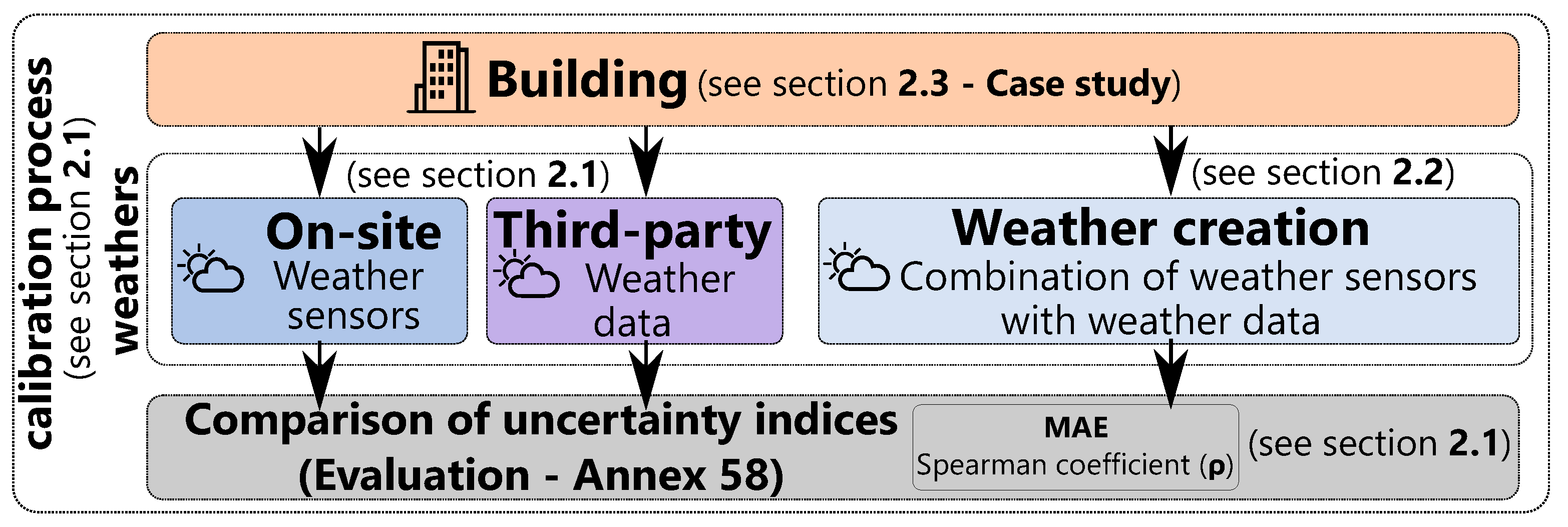

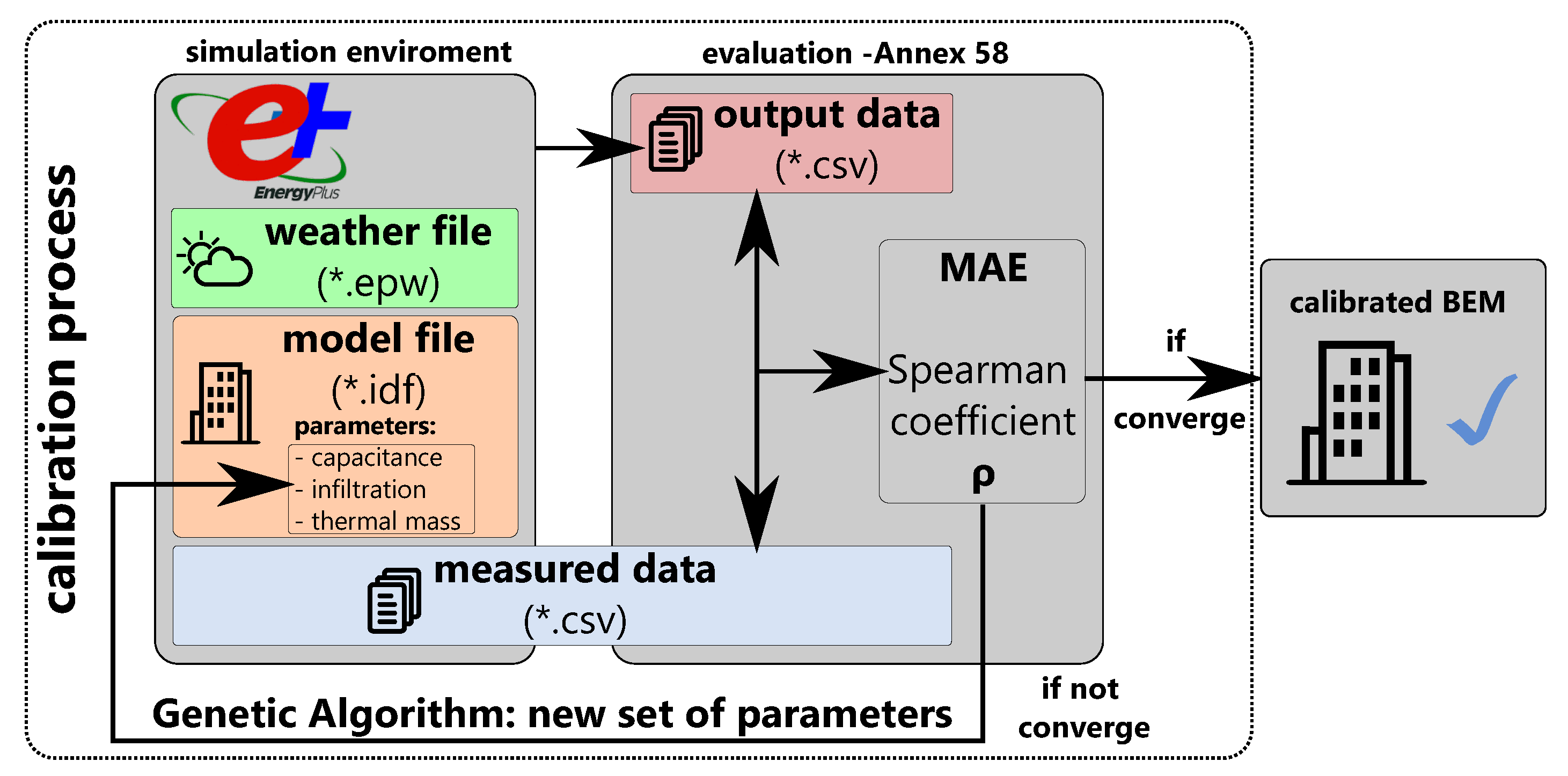

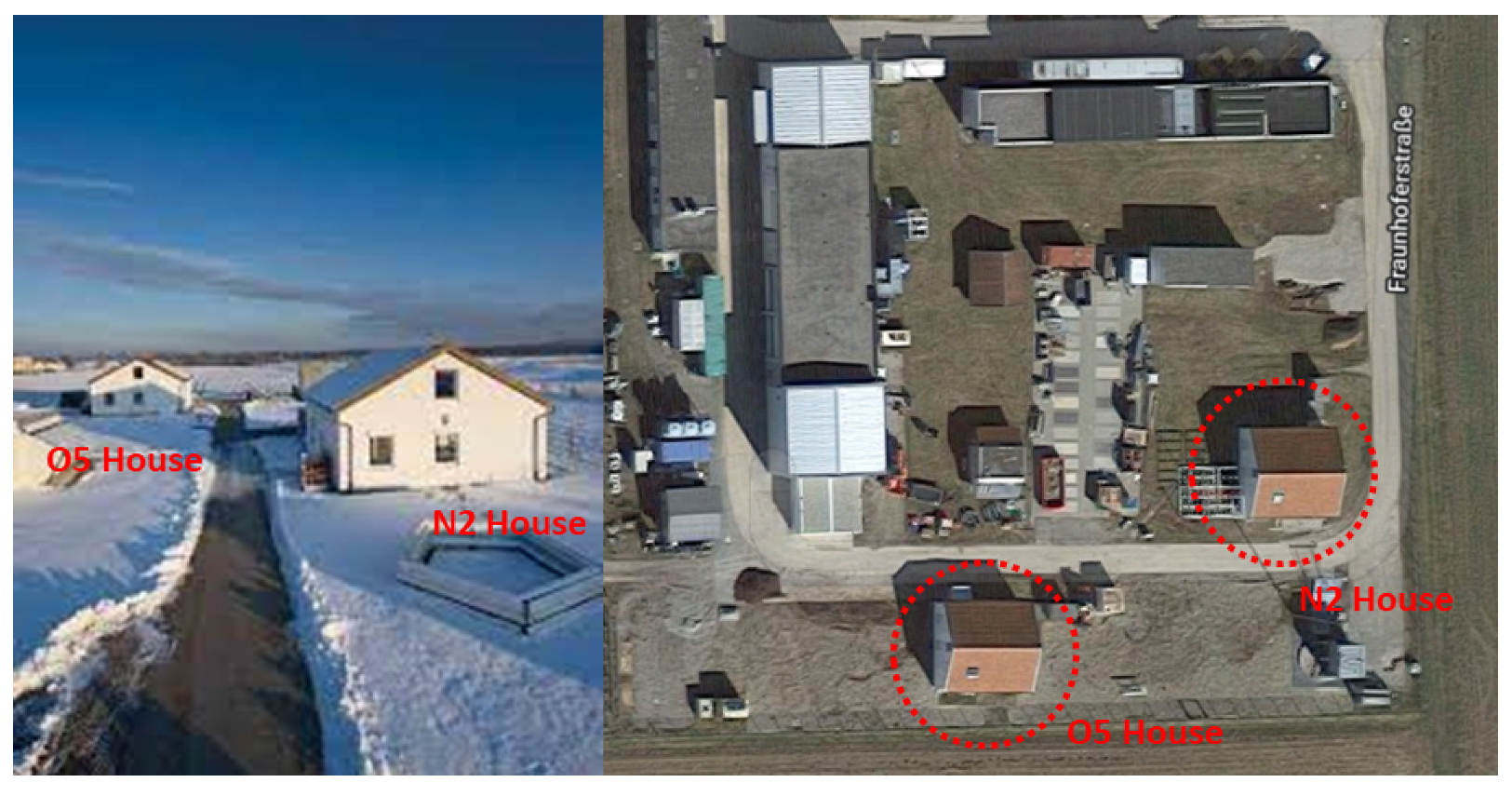


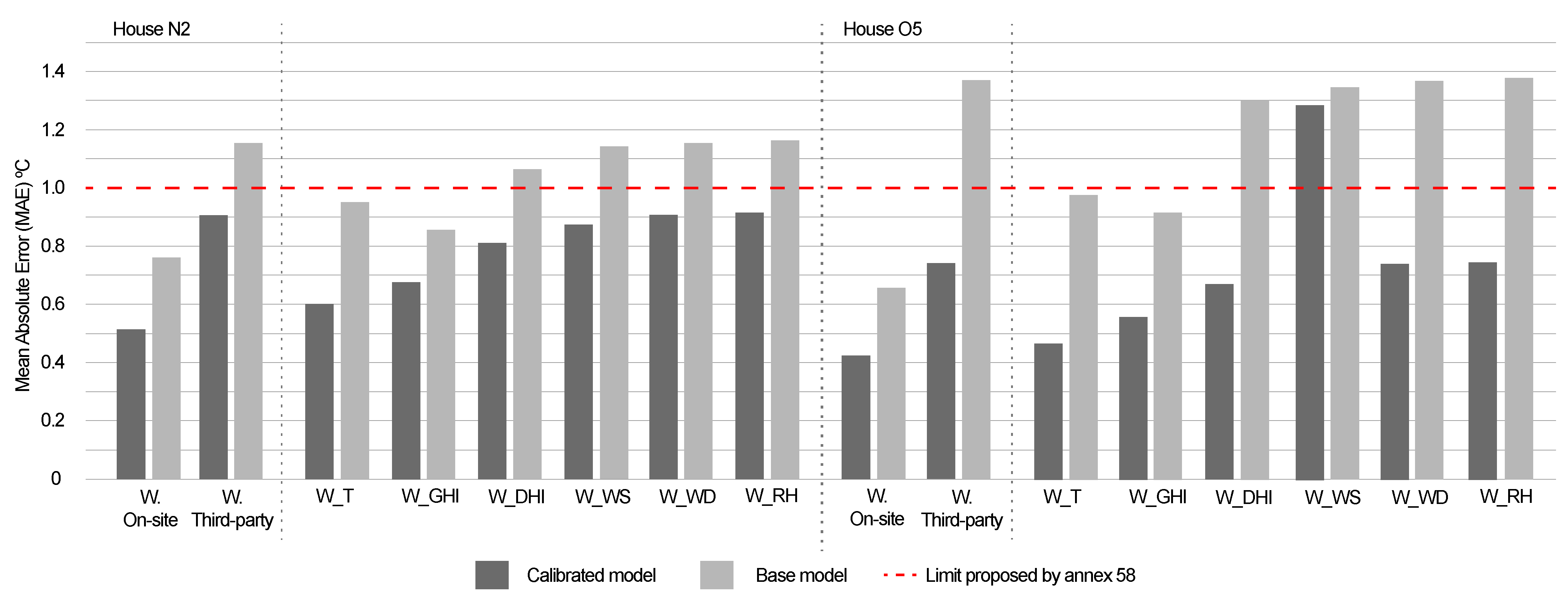
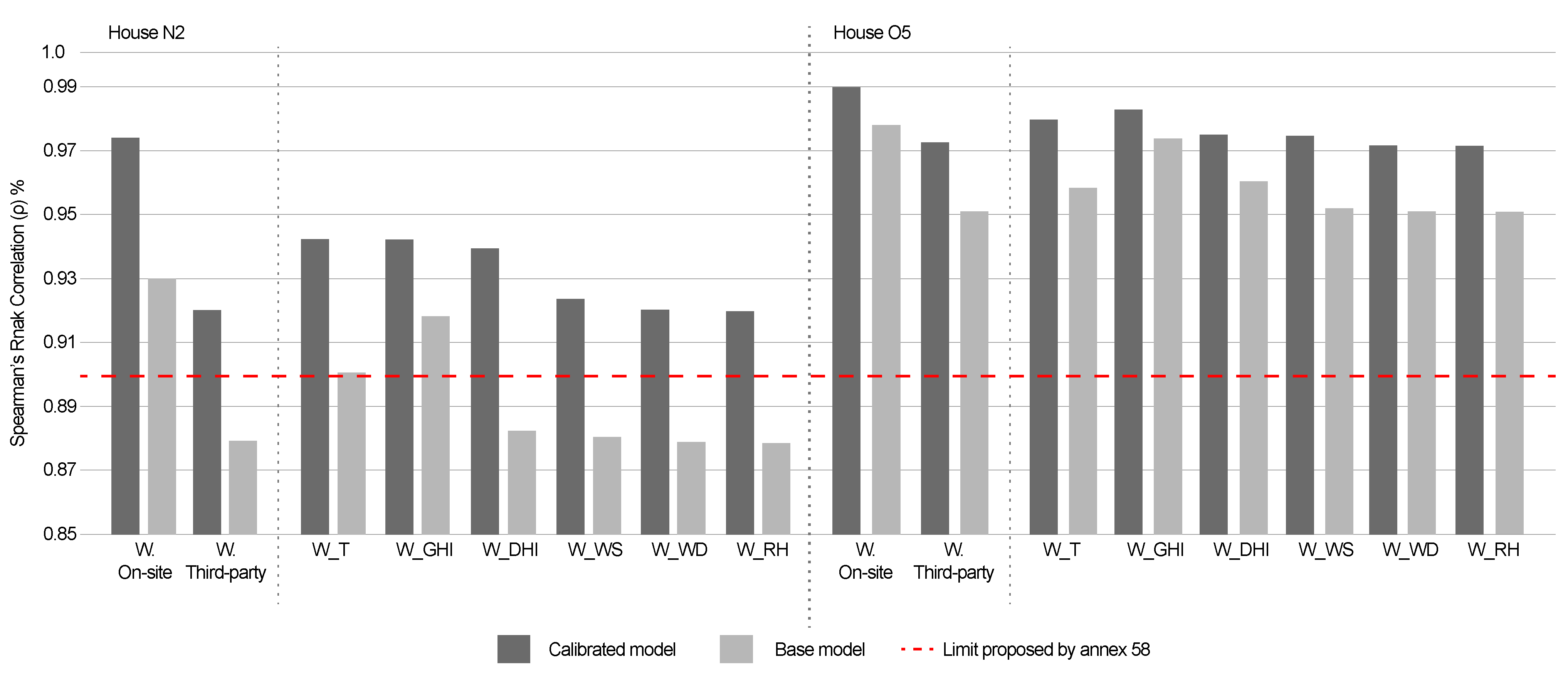
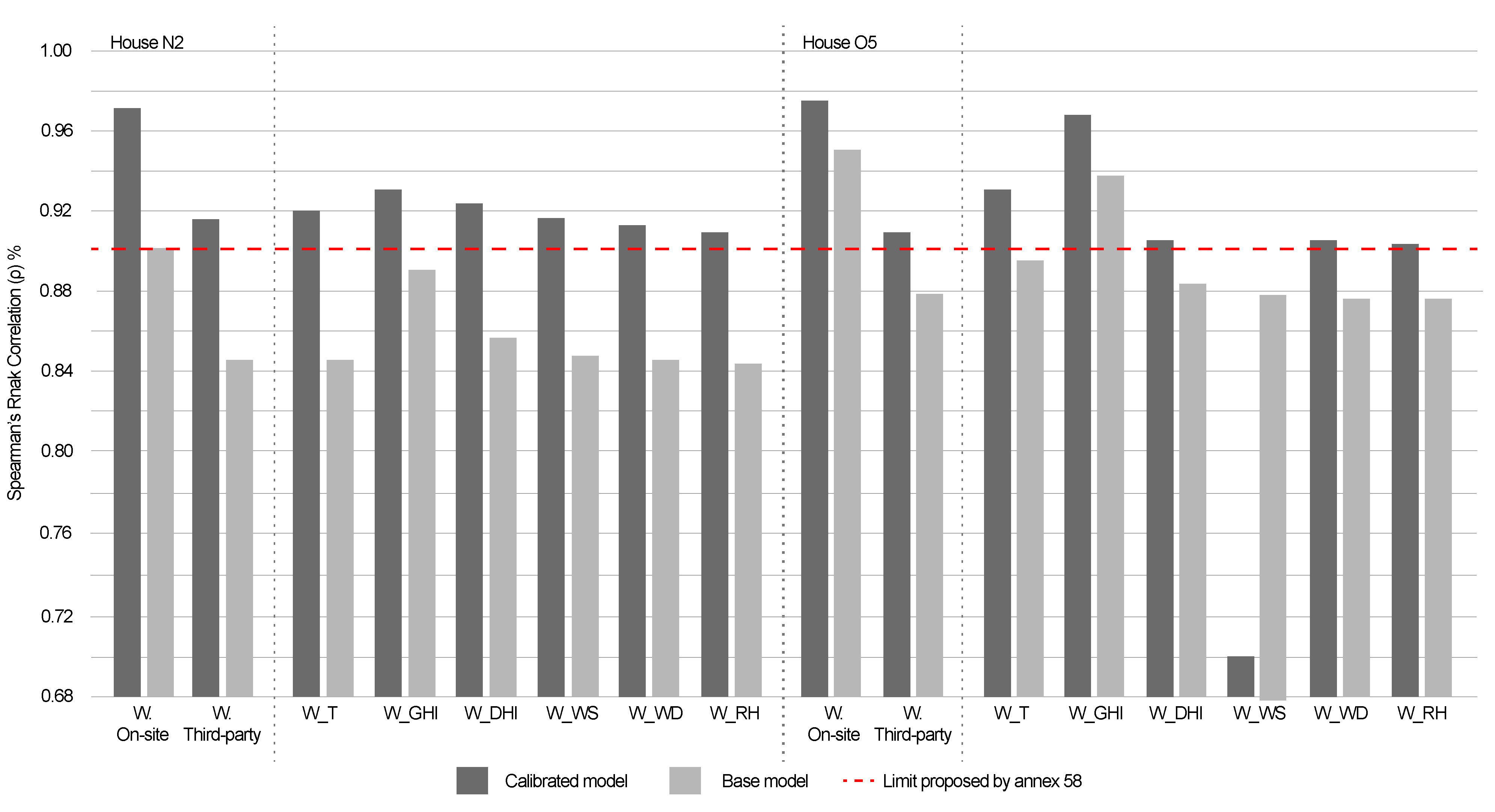
| Period | Date | Configuration | Data | Data | |
|---|---|---|---|---|---|
| Beginning | End | Provided | Requested | ||
| Period 1 | 21 August 2013 | 23 August 2013 | Initialization (constant temperature) | Temperature and heat inputs | - |
| Period 2 | 23 August 2013 | 30 August 2013 | Constant temperature (nominal 30 C) | Temperature and heat inputs | Heat outputs |
| Period 3 (Calibration) | 30 August 2013 | 14 September 2013 | ROLBS heat inputs in living room | Temperature and heat inputs | Temperature outputs |
| Period 4 | 14 September 2013 | 20 September 2013 | Re-initialization Constant temp. (nominal 25 C) | Temperature and heat inputs | Heat outputs |
| Period 5 (Checking) | 20 September 2013 | 30 September 2013 | Free float | Temperature inputs | Temperature outputs |
| House | Model | Weather File Name | Simulation Period | Living Room | Children Room | Bedroom | Kitchen | Global Index | |||||
|---|---|---|---|---|---|---|---|---|---|---|---|---|---|
| MAE (C) | (%) | MAE (C) | (%) | MAE (C) | (%) | MAE (C) | (%) | MAE (C) | (%) | ||||
| N2 | Base | On-site | Training | 1.54 | 96.6 | 0.25 | 98.7 | 0.5 | 97.2 | 0.90 | 96.5 | 0.81 | 93.0 |
| N2 | Base | On-site | Checking | 1.82 | 91.9 | 0.23 | 99.6 | 0.33 | 98.3 | 0.66 | 95.5 | 0.76 | 90.1 |
| N2 | Base | Third-party | Training | 1.21 | 94.9 | 0.66 | 99.1 | 1.16 | 94.7 | 2.57 | 90.55 | 1.40 | 87.9 |
| N2 | Base | Third-party | Checking | 0.84 | 87.5 | 0.74 | 99.4 | 0.93 | 97.2 | 2.10 | 86.2 | 1.15 | 84.5 |
| N2 | Calibrated | On-site | Training | 0.56 | 98.6 | 0.41 | 98.2 | 0.44 | 96.8 | 0.80 | 95.1 | 0.55 | 97.4 |
| N2 | Calibrated | On-site | Checking | 0.32 | 99.7 | 0.60 | 99.8 | 0.38 | 98.8 | 0.74 | 93.7 | 0.51 | 97.1 |
| N2 | Calibrated | Third-party | Training | 0.98 | 96.2 | 0.43 | 99.0 | 0.77 | 92.0 | 1.73 | 90.2 | 0.98 | 92.0 |
| N2 | Calibrated | Third-party | Checking | 0.50 | 94.0 | 0.73 | 99.5 | 0.82 | 97.8 | 1.58 | 85.6 | 0.90 | 91.5 |
| O5 | Base | On-site | Training | 1.46 | 98.7 | 0.60 | 98.7 | 0.28 | 98.6 | 0.48 | 98.4 | 0.71 | 97.8 |
| O5 | Base | On-site | Checking | 1.31 | 97.9 | 0.54 | 99.7 | 0.26 | 97.4 | 0.50 | 96.9 | 0.65 | 95.0 |
| O5 | Base | Third-party | Training | 2.10 | 95.9 | 1.26 | 98.1 | 0.82 | 96.0 | 1.83 | 93.3 | 1.50 | 95.0 |
| O5 | Base | Third-party | Checking | 1.68 | 84.4 | 1.43 | 97.8 | 0.70 | 94.0 | 1.64 | 88.1 | 1.37 | 87.7 |
| O5 | Calibrated | On-site | Training | 0.65 | 98.6 | 0.25 | 99.1 | 0.30 | 97.8 | 0.36 | 97.9 | 0.40 | 98.9 |
| O5 | Calibrated | On-site | Checking | 0.50 | 98.2 | 0.50 | 98.7 | 0.30 | 99.3 | 0.40 | 97.9 | 0.42 | 97.5 |
| O5 | Calibrated | Third-party | Training | 1.64 | 95.9 | 0.29 | 98.5 | 0.35 | 95.3 | 0.40 | 97.0 | 0.67 | 97.2 |
| O5 | Calibrated | Third-party | Checking | 1.43 | 86.1 | 0.38 | 96.3 | 0.41 | 96.4 | 0.74 | 94.0 | 0.74 | 90.7 |
| House | Weather File | Global MAE | Global MAE | House | Weather File | Global MAE | Global MAE |
|---|---|---|---|---|---|---|---|
| Base Model | Calibrated Model | Base Model | Calibrated Model | ||||
| N2 | On-site | 0.81 | 0.55 | O5 | On-site | 0.71 | 0.39 |
| N2 | Third-party | 1.40 | 0.98 | O5 | Third-party | 1.50 | 0.67 |
| N2 | Weather_T | 1.15 | 0.69 | O5 | Weather_T | 1.14 | 0.51 |
| N2 | Weather_GHI | 1.10 | 0.75 | O5 | Weather_GHI | 1.24 | 0.59 |
| N2 | Weather_DHI | 1.22 | 0.82 | O5 | Weather_DHI | 1.28 | 0.58 |
| N2 | Weather_WS | 1.38 | 0.93 | O5 | Weather_WS | 1.46 | 0.69 |
| N2 | Weather_WD | 1.40 | 0.98 | O5 | Weather_WD | 1.50 | 0.66 |
| N2 | Weather_RH | 1.40 | 0.98 | O5 | Weather_RH | 1.51 | 0.67 |
| House | Weather File | Global MAE | Global MAE | House | Weather File | Global MAE | Global MAE |
|---|---|---|---|---|---|---|---|
| Base Model | Calibrated Model | Base Model | Calibrated Model | ||||
| N2 | On-site | 0.76 | 0.51 | O5 | On-site | 0.65 | 0.42 |
| N2 | Third-party | 1.15 | 0.90 | O5 | Third-party | 1.37 | 0.74 |
| N2 | Weather_T | 0.95 | 0.60 | O5 | Weather_T | 0.98 | 0.47 |
| N2 | Weather_GHI | 0.85 | 0.67 | O5 | Weather_GHI | 0.91 | 0.56 |
| N2 | Weather_DHI | 1.06 | 0.81 | O5 | Weather_DHI | 1.30 | 0.67 |
| N2 | Weather_WS | 1.14 | 0.87 | O5 | Weather_WS | 1.35 | 1.28 |
| N2 | Weather_WD | 1.15 | 0.90 | O5 | Weather_WD | 1.37 | 0.74 |
| N2 | Weather_RH | 1.16 | 0.91 | O5 | Weather_RH | 1.38 | 0.75 |
Publisher’s Note: MDPI stays neutral with regard to jurisdictional claims in published maps and institutional affiliations. |
© 2022 by the authors. Licensee MDPI, Basel, Switzerland. This article is an open access article distributed under the terms and conditions of the Creative Commons Attribution (CC BY) license (https://creativecommons.org/licenses/by/4.0/).
Share and Cite
Gutiérrez González, V.; Ramos Ruiz, G.; Du, H.; Sánchez-Ostiz, A.; Fernández Bandera, C. Weather Files for the Calibration of Building Energy Models. Appl. Sci. 2022, 12, 7361. https://doi.org/10.3390/app12157361
Gutiérrez González V, Ramos Ruiz G, Du H, Sánchez-Ostiz A, Fernández Bandera C. Weather Files for the Calibration of Building Energy Models. Applied Sciences. 2022; 12(15):7361. https://doi.org/10.3390/app12157361
Chicago/Turabian StyleGutiérrez González, Vicente, Germán Ramos Ruiz, Hu Du, Ana Sánchez-Ostiz, and Carlos Fernández Bandera. 2022. "Weather Files for the Calibration of Building Energy Models" Applied Sciences 12, no. 15: 7361. https://doi.org/10.3390/app12157361






